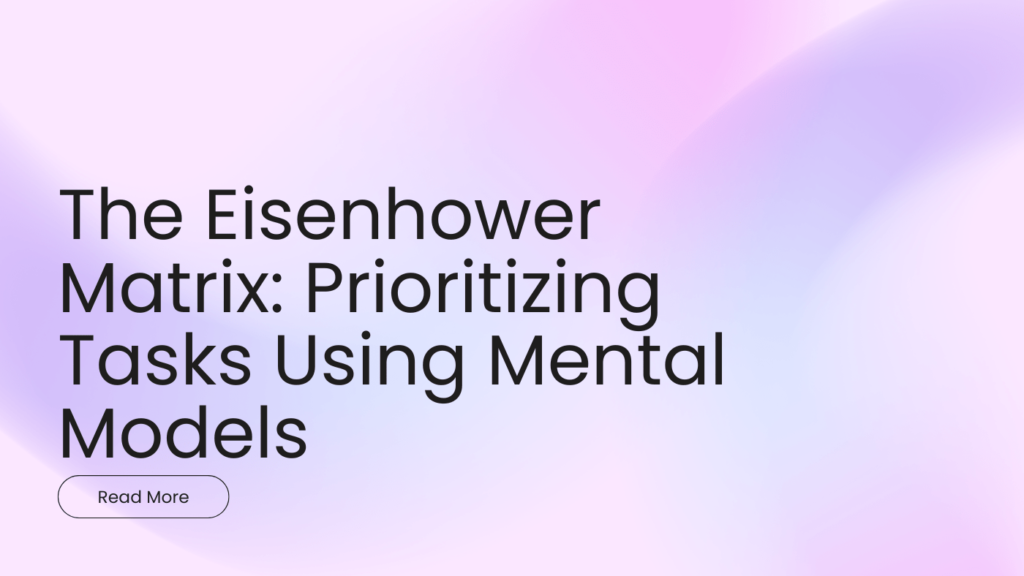Mastering Your Time: The Eisenhower Matrix & Mental Models for Peak Productivity
Feeling overwhelmed by a never-ending to-do list? Do you struggle with prioritizing tasks effectively? You’re not alone. Many professionals, entrepreneurs, and students grapple with time management and productivity daily. Luckily, there’s a powerful tool combined with the strategic use of mental models that can help you regain control of your schedule and focus on what truly matters: the Eisenhower Matrix.
What is the Eisenhower Matrix? (The Urgent-Important Principle)
Also known as the Urgent-Important Matrix, the Eisenhower Matrix is a simple yet highly effective prioritizing tasks framework developed and popularized by Dwight D. Eisenhower, the 34th President of the United States and a renowned master of time management. The matrix divides your tasks into four quadrants based on their urgency and importance:
- Quadrant 1: Urgent and Important (Do First): These are crises, deadlines, and pressing problems. They demand immediate attention. Examples: A critical system failure, a looming deadline, a medical emergency.
- Quadrant 2: Not Urgent but Important (Schedule): These are activities that contribute to long-term goals, personal growth, and prevention. They require proactive scheduling. Examples: Planning, exercise, relationship building, skill development.
- Quadrant 3: Urgent but Not Important (Delegate): These are interruptions, some meetings, and requests that can be handled by someone else. Examples: Certain emails, unnecessary meetings, some phone calls.
- Quadrant 4: Not Urgent and Not Important (Eliminate): These are distractions, time wasters, and activities that contribute little to nothing to your goals. Examples: Excessive social media browsing, mindless entertainment, time-wasting meetings.

A visual representation of the Eisenhower Matrix. (Replace with your own image)
Why the Eisenhower Matrix Works for Prioritizing Tasks
The power of the Eisenhower Matrix lies in its simplicity and its ability to force you to critically evaluate each task. It helps you:
- Gain Clarity: It forces you to differentiate between what’s truly important and what’s merely urgent.
- Reduce Stress: By prioritizing effectively, you can tackle the most crucial tasks first, reducing feelings of overwhelm.
- Improve Focus: By eliminating or delegating non-essential tasks, you free up time and mental energy for what matters most.
- Boost Productivity: Focusing on Quadrant 2 activities leads to long-term growth and prevents future crises.
Leveraging Mental Models for Enhanced Productivity
While the Eisenhower Matrix provides a framework, using mental models can significantly enhance its effectiveness. Mental models are simplified representations of how something works. They help us understand complex situations, make better decisions, and predict outcomes. Applying them to the Eisenhower Matrix helps you to make more informed choices about where to allocate your time and energy.
Mental Models to Supercharge Your Eisenhower Matrix Implementation
- First Principles Thinking: This model encourages you to break down complex problems into their fundamental truths. When assessing a task, ask yourself, “What is the core purpose of this task? What are the essential components?” This helps you accurately determine its importance and urgency. Referencing Farnam Street’s explanation of First Principles can give you a deeper understanding.
- Pareto Principle (80/20 Rule): The Pareto Principle states that roughly 80% of effects come from 20% of causes. In the context of the Eisenhower Matrix, identify the 20% of your activities that yield 80% of your results. Focus heavily on these Quadrant 2 activities. Corporate Finance Institute offers a detailed explanation of the Pareto Principle.
- Opportunity Cost: Every decision involves a trade-off. By choosing to do one thing, you’re implicitly choosing not to do something else. When evaluating a task, consider the opportunity cost – what else could you be doing with that time and energy that would be more valuable? This is especially crucial when deciding whether to delegate (Quadrant 3) or eliminate (Quadrant 4) tasks. A comprehensive look at opportunity cost can be found at Investopedia’s definition.
- Inversion: Instead of asking “How can I achieve this?”, ask “How can I *prevent* achieving this?” This helps identify potential pitfalls and distractions that would derail your productivity. Apply this to Quadrant 4 activities; identify what actively prevents you from focusing on important, non-urgent tasks.
- Second-Order Thinking: Consider the consequences of your actions, not just immediately, but also down the line. A seemingly “urgent” task might have negative long-term consequences if you prioritize it over more important, non-urgent activities. This aligns with the long-term focus of Quadrant 2.
Implementing the Eisenhower Matrix: A Step-by-Step Guide
- Create Your Matrix: Draw a 2×2 grid and label the quadrants as described above. You can do this on paper, in a spreadsheet, or using a digital tool.
- Brain Dump: Write down all the tasks, projects, and commitments you have on your plate. Don’t censor yourself; just get everything out of your head.
- Categorize Each Task: For each task, ask yourself:
- Is this task important to achieving my goals?
- Is this task urgent and requiring immediate attention?
Based on your answers, place the task into the appropriate quadrant.
- Take Action:
- Quadrant 1 (Urgent and Important): Do these tasks immediately.
- Quadrant 2 (Not Urgent but Important): Schedule time in your calendar to work on these tasks. Treat these appointments as non-negotiable.
- Quadrant 3 (Urgent but Not Important): Delegate these tasks to someone else who can handle them effectively.
- Quadrant 4 (Not Urgent and Not Important): Eliminate these tasks entirely. Say “no” to commitments that don’t align with your goals.
- Review and Adjust: Regularly review your matrix (daily or weekly) to ensure it reflects your current priorities and adjust accordingly. Priorities shift, so be flexible.
Tools to Help You Use The Eisenhower Matrix
- Trello (with labels and lists corresponding to the quadrants)
- Asana (Similar to Trello, offers project management features)
- Todoist (a popular to-do list app that allows task prioritization)
- Physical Notebook and Pen (Sometimes the simplest method is the best!)
Conclusion: Transform Your Productivity with the Eisenhower Matrix and Mental Models
The Eisenhower Matrix is a powerful tool for prioritizing tasks and reclaiming control of your time. By combining it with the strategic application of mental models, you can make more informed decisions, eliminate distractions, and focus on the activities that truly matter. Start implementing this system today and experience a significant boost in your productivity and overall well-being. It’s not just about working harder; it’s about working smarter.


